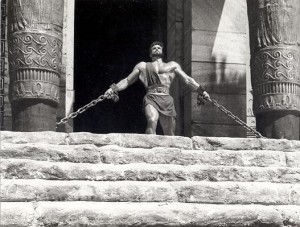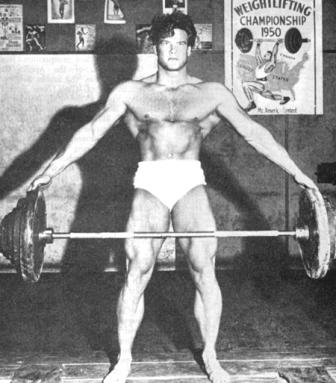Hercules Chained
by Thom Van Vleck

Who can forget Steve Reeves in "Hercules Unchained"using the chains that imprisoned him to then turn the tables and vanquish his enemy.
Have you been workin’ on the Chain Gang? Well, earlier in this century that would not have been a compliment when prisoners were put to hard, manual labor all while chained to each other or chained to an iron ball to keep them from running away. The word “Chain” comes from a latin word that referred to a “snare” or “net”. In Modern times when we think of chains we might think of Chain mail, Chain of stores, or a Chain reaction. But what I’m talking about today using metal chains to help you get stronger in your lifting.
A few years back I bought 40 feet of half inch chain. The half inch is the diameter of the rod used to make the chain, which means they were quite big and they weighed about 2lbs a foot. I initially bought them to use in our strongman shows. I would do this squat and offer my personal testimony on how my legs had been broken badly and my faith had let to my recovery. I found that most folks didn’t relate will to a barbell so I bought the chain and draped it over me, the bar and the weights. I would also use it as an object lesson on how we can become “chained” by lies and sin and forgiveness can set us free from that burden.
Then they started to become more and more popular for training in general. Often they are hung on the ends of barbells or in some way so that as you lift, you slowly pull more and more chain from the floor. So if I had a 300lb barbell and 100lbs of chains on a squat bar then at the start of the squat you would have 400lbs on your shoulders. As you went down and the chaines slowly bunch up on the floor you would drop the weight to 300lbs at the bottom. I think there are several reason they can be a help to training.
First, the practical reasons:
1. Increased stability. Nothing like a shifting weight to make you work to stabilize the weight. This is one advantage chains have over using the rubber bands….you are challenges to keep the weight balanced. One of the reasons barbells are superior to machines is this factor and chains amp that factor up.
2. Speed training. It’s not uncommon on some lifts, like the squat, to find yourself backing off at the top. Having the chains increasing the weight as you go up causes you to keep pushing. My opinion is that increases the efficiency of the lift for the athlete and makes it more useful for those lifting for other reasons than weightlifting competition.
3. Weak Points. Chains might help you work on your weak points or sticking points. Sure, this is debatable but in my mind you basically take one lift with chains and do two lifts at once. For example, on the bench press you can do a full movement then work on your lock outs with partials….or just do bench’s with chains and increase the load at the top!
Second, the mental impact:
1. If you use chains and then switch to a regular barbell, the regular barbell will seem easier to handle and increase your confidence.
2. We can all get stale or stagnant in our training and adding chains can mix things up and bring some freshness to your training.
3. Finally….let’s face it…chains hanging around your gym look cool and I’ll admit….a couple of times I’ve grabbed a hold of a couple of 8 ft sections of my largest chain and done my best “Steve Reeves” impression! When I bring people who don’t train regularly to see my gym guess what one of the first things they focus on….the BIG CHAINS.
I’m not making any promises that you will add big pounds to your lifts using chains. I’m just offering up some ideas to add to your arsenal of training methods. I wouldn’t…and don’t….use them year around. I mix them in here and there. Chains are symbolic in so many ways and they can get your most important training tool inspired and working hard again….YOUR BRAIN. Get some chains and become Hercules…but CHAINED!
